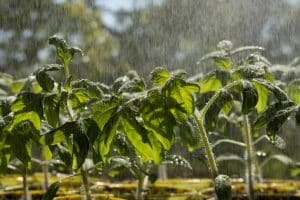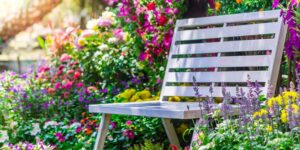
Best Perennials for Pollinators
By Rob Sproule
Salvia
Monarda (Bee Balm)
Thyme
Hollyhocks
“The hum of bees is the voice of the garden.”
– Elizabeth Lawrence
We all love bees, but getting them into your yard doesn’t happen on its own. Beyond the good feeling from having them there, they bring the massive benefit of increased edible production across our yard (and our neighbors’ yards).
Filling the yard with exotic annuals won’t get you there, but perennials will. Here are a few of the best perennials, all of which are hardy, easy to grow, and readily available.
Salvia:
This is huge group of plants that includes natives, exotics, herbals, and ornamentals. We aren’t here to talk about the bright red annuals you buy in the spring, however; bees aren’t especially fond of them. Let’s talk about the old school sage plants, with their tall, blue flower spikes.
Perennial salvia tops out under 2 feet tall and makes a hardy filler plant, with a cottage garden vibe. When not in bloom, it’s neither the prettiest nor the neatest, but the bees are drawn to it like a fish to water. Once in your garden, they will help your entire garden yield more of everything, from beans to berries to apples.
Salvias don’t need any special care, a sunny spot, average soil, and a splash of water (if it hasn’t rained in a while) will do nicely.
Monarda (Bee Balm):
With a name like Bee Balm, of course the bees will love it! Monarda is a summer bloomer that grows a few feet tall and yields pollen-filled clusters of tubular flowers. Besides being irresistible to bees, it’s also a valuable food source for monarch butterflies!
Monarda has a country, cottage look and would fit perfectly into a British-inspired garden. A woodland plant, it likes its soil moist, but not wet, and will thank you for some afternoon shade.
At about 3 feet high, use Monarda as a backdrop in your perennial beds. It’s very hardy and requires no extra fall care, and very little care in general.
Dig in with Alberta’s Best Gardening Blog for more tips on how to keep your pollinators happy!
Thyme:
On sunny, summer days when the thyme is blooming, the familiar, soothing buzz of bees usually isn’t far away. It doesn’t matter what variety of thyme you plant, as soon as those little, purple flowers open, the bees will flock.
Thyme isn’t the most eye-catching flower in the garden. It doesn’t put on as big a show as those braggart lilies do, but it’s as tough as they come. You can make small patches of stepable lawn with it and it will survive the winter better than most rocks. Not only does it not need special care, it barely needs any care at all. Give it sun, sparse watering (rain is often enough), and step on it now and then.
Thyme honey is considered one of the best varieties out there, both for taste and health benefits. Of course, there are also a number of herbal uses for thyme as well, depending on the variety you plant, so be sure to do your research.
Hollyhocks:
These tall, stately perennials are one of the best backdrops for a fence or wall. They can top 5 feet high and bloom in masses of brightly coloured flowers, coated with copious pollen, all the way up the stem.
Bees are drawn in both by the colour and the clusters of flowers, which make an extra visit well worth their while (bees are very efficiency focused). They are a valuable food source and easy to grow.
Plant your hollyhocks in full sun or partial shade. Fertilize in the spring and enjoy the vertical spires of colours throughout the summer. They’re very hardy and don’t need any further fall care.
With these fresh, fragrant herbs in your garden, you’ll be sure to catch a buzz or two this spring. The bees will be begging to visit the best plot on the block, so roll up your sleeves for your best bounties yet!















